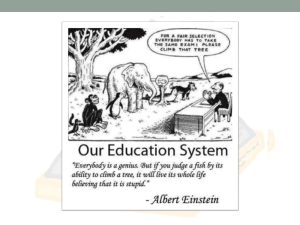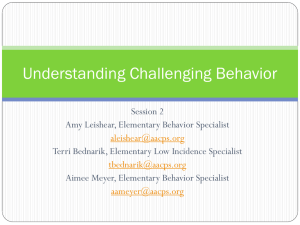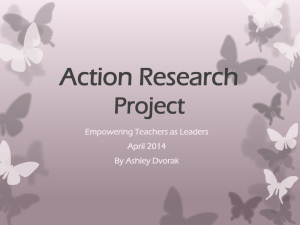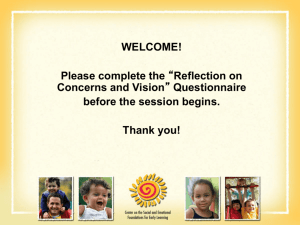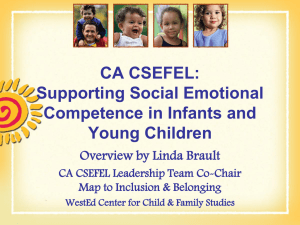September 21, 2011 Early Childhood Forum PowerPoint
advertisement
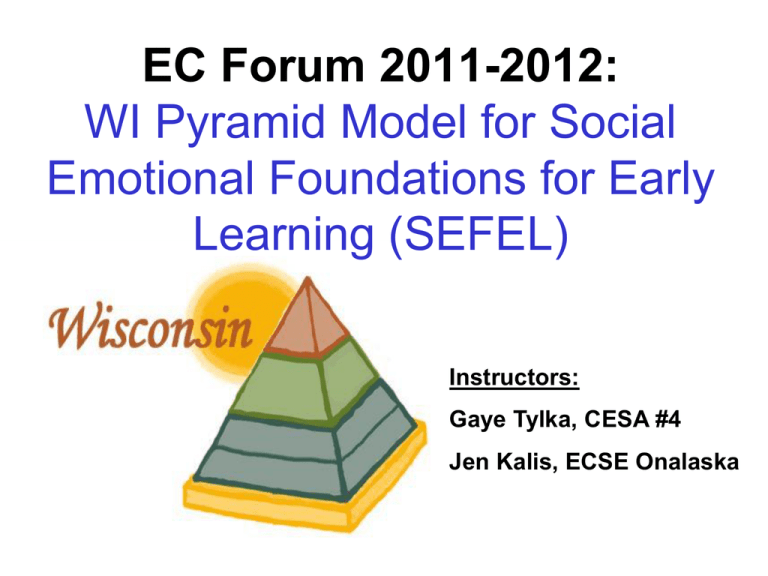
EC Forum 2011-2012: WI Pyramid Model for Social Emotional Foundations for Early Learning (SEFEL) Instructors: Gaye Tylka, CESA #4 Jen Kalis, ECSE Onalaska …That’s Me! If the statement is TRUE for you, stand up and say, “That’s me” I took a fun trip this summer… •I have a dog… •I love chocolate… •I love wine… •I could have used a few more weeks of summer… •I had a major life event this summer (wedding, baby, family, new job, etc.) • …That’s Me! If the statement is TRUE for you, stand up and say, “That’s me” I work with infants and toddlers… •I teach 1st grade or beyond… •I teach early childhood special education… •I work with 4 Year Olds in a Preschool or 4K program… •I provide supportive services or teach special subjects to children: PE teacher,speech-teacher, ADPE, PT, OT, etc…. •I teach at a child care or private preschool… •I am a Paraprofessional/Educational Assistant… •I teach kindergarten… •I love working with young children! • What will we talk about today? Overview of Pyramid Model and R&R (RTI) •Connect of WI Pyramid Model to PBIS •Behaviors that challenge us • The importance of relationships • Strategies to build positive relationships • Brief overview of • Attachment Regulation Temperament The Pyramid Model/CSEFELConnection to RTI/R&R Table Activity: At your tables, complete the blank Pyramid Model by discuss the definitions and making your best guess as to how it fits in the pyramid. Use each other as resources. Pyramid ModelAt A Glance Content based upon CSEFEL training modules, a federally projected based at Vanderbilt University Goal is to disseminate evidence-based practices to improve social and emotional outcomes for young children Called in WI- “The WI Pyramid Model” Aligned with PBIS and RTI 4/26/12: GRAD Presentations 3/8/12 Children with persistent challenges Individualized Positive Behavior Support 1/12/12 Social Skills Curricula Children AtRisk 11/10/11 All Children 9/22/11 High quality early education Basic Assumptions • Challenging behavior usually has a message- I am bored, I am sad, you hurt my feelings, I need some attention. • Children often use challenging behavior when they don’t have the social or communication skills they need to engage in more appropriate interactions. 10 Basic Assumptions (cont.) • Behavior that persists over time is usually working for the child. • We need to focus on teaching children what to do in place of the challenging behavior. A Foundational idea of the Pyramid Model Every behavior has a purpose! Quick Time™ an d a d eco mp res sor ar e n eed ed to s ee this pic ture . Quick Time™ an d a d eco mp res sor ar e n eed ed to s ee this pic ture . QuickTime™ and a decompressor are needed to see this picture. Hot Button Activity (a.k.a Jen’s Therapy) 1. What behaviors “Push Your Buttons”? 2. How do YOU feel when faced with these behaviors? 3. What impact do those feelings have on the relationship with the child who exhibits those behaviors Think of a child you work with who has challenging behaviors and/or inadequate socialemotional skills. Now complete the following questions on your own paper. Discuss your answers at your tables. Remember… Children with challenging behaviors especially need positive, supportive relationships and yet their behaviors often prevent them from benefiting from those relationships The Pyramid Model for Social Emotional Competence We Are Here WI Pyramid Model in Action Dealing with REAL children who have challenging behaviors. One mother’s perspective. http://www.youtube.com/watch?v=TY1fnegoMjc Building Relationships with Children Why is it important? ●Relationships helps children feel accepted by group ●Relationships assists children in learning to communicate with others ●Relationships begins to teach empathy and respect among children and adults ●Children build emotional connections with others Building Relationships with Children ● Children start to create memories and expectations for future relationships ● Relationships are the foundation of EVERYTHING we do! ● Children learn and develop in the context of relationships which are responsive, consistent, and nurturing Building relationships with each other The relationships we build with children, families, and colleagues form the foundation of quality programming Inventory of Practices for Promoting Children’s Social Emotional Competence Purpose of the Inventory: The Inventory of Practices for Promoting Social Emotional Competence is designed to be used by individuals and/or teams to identify training needs and plan a course of action to address those needs related to four general areas: (a) building positive relationships, (b) creating supportive environments, (c) social emotional teaching strategies, and (d) individualized intensive interventions. There are two sections to this tool: the Inventory of Practices and the Action Plan. Attachment Is a reciprocal, profound, emotional and physical relationship between a child and his parent/primary caregiver Sets the stage for all future intimate, trusting relationships Endures over time and place. We are hard wired for relationships At the heart of developing a secure attachment is the knowledge that your caregiver is emotionally available to be with you in times of need - Building Relationships • Helps each child feel accepted in the group • Assists children in learning to communicate and get along with others • Encourages feelings of empathy and mutual respect among children and adults • Provides a supportive environment in which children can learn and practice appropriate and acceptable behaviors as individuals and as a group Building Relationships with Children Why is it important? 1. The relationships that we build with children, families, and colleagues are at the foundation of everything we do. It is important to build these relationships early on rather than waiting until there is a problem. 2. Children learn and develop in the context of relationships that are responsive, consistent, and nurturing. 3. Children with the most challenging behaviors especially need these relationships, and yet their behaviors often prevent them from benefiting from those relationships. 4. Adults’ time and attention are very important to children, and we need to be sure that we are giving them that time and attention at times other than when they are engaging in challenging behavior. 5. Parents and other colleagues (such as mental health providers and therapists) are critical partners in building children’s social emotional competence. We should all work together to ensure children’s success and prevent challenging behavior. QuickTime™ and a Video 1.1: Adult Child Conversations YUV420 codec decompressor are needed to see this picture. What are some things that this teacher does to build positive relationships with children? Building Relationships At your tables, discuss the following: How do you build relationships with children? Share a few good ideas. How do you build relationships with parents? What works well? What doesn’t work? How do you build relationships with co-workers, administrators, etc. Reflect: What would you like to work on? How? Strategies for Building Authentic Relationships Praise effort, not IQ (Resource: “Brain Rules for Baby: How to Raise a Smart and Happy Child from Zero to Five”) Go beyond “Good Job”- use encouragement vs. empty praise. What you praise defines what your child perceives success to be. Guided play- every day! Practice pretending, have a play plan, get “in there” with the kids. Empathy- the glue of relationships. Empathy needs to be practiced, modeled, and taught to develop strong relationships. “Every child needs one person who is crazy about him.” Uri Bronfenbrenner Key Social Emotional Skills Children Need as They Enter School • Confidence • Capacity to develop good relationships with peers and adults • Concentration and persistence on challenging tasks • Ability to effectively communicate emotions • Ability to listen to instructions and be attentive • Ability to solve social problems What do children do when they don’t have each of these skills? • When children do not have these skills, they often exhibit challenging behaviors • We must focus on TEACHING the skills! Children need to LEARN self-regulation skills Regulated What tells adults a child is regulated? Dysregulated What tells adults a child is dysregulated? What are characteristics of a child who regulates his/her emotional system well? What are characteristics of a child who does not regulate his/her emotional system well? What is temperament? • Biologically based individual differences in emotional, motor, attentional reactivity, and self- regulation. These differences are relatively stable over time and consistent across situations. Temperament Types Thomas and Chess Flexible Fearful Feisty Regular rhythms Adapts slowly Active Positive mood Withdraws Intense Easy adaptation Shy/Timid Distractible Low intensity Low sensitivity Approachable May resist new things at first Sensitive Irregular Moody Reflection Activity • • • • Complete the temperament scale on yourself. Complete the temperament scale on a child with behavior you feel is challenging. You may need to observe the child before filling out the scale. What did you notice when you compared the ratings? Complete the Considering Temperament handout from the child’s perspective. Promoting Social Emotional Development Helps Children: ●Develop confidence ●Develop relationships with peers and adults ●Communicate emotions appropriately ●Listen to instruction and to be attentive ●Solve social problem ●Build confidence in themselves ●Learn appropriate behaviors through encouragement ●Learn what adults expect of them and what they can expect from other people If there is anything that we wish to change in the child, we should first examine it and see whether it is not something that could better be changed in ourselves. Carl Jung – psychiatrist Major Messages • The first and most important thing that we can do is to build positive relationships with every child and family. • Focus on prevention and teaching appropriate skills. • Promoting social emotional development is not easy. There are no quick fixes to challenging behavior. • It requires a comprehensive approach that includes building relationships, evaluating our own classrooms and behaviors, and TEACHING. Websites ●CSEFEL - Center on the Social Emotional Foundations for Early Learning http://www.vanderbilt.edu/csefel/ •TACSEI - Technical Assistance Center on Social Emotional Intervention http://www.challengingbehavior.org/
